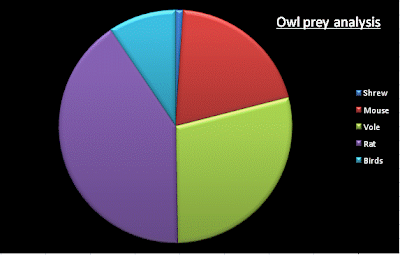1. Based upon the class data, rank the most frequently consumed prey for the class "owl population".The prey that the owl population feeds the most on is rat. This is followed by vole, and mouse. Then, it is birds, and finnaly shrew. The owl population doesn't consume insects.
2.A predator expends energy when hunting for food. Which is the more "energy expensive" cuisine, 35 insects at 1 g each or one 35 g vole?
For the owl, it would be the most energy efficient if it caught the vole. This is because to catch 35 insects, the owl would waste even more energy, then it would gain by eating them. As for the vole, it is just one organism, and it can be caught much more easily and much more simply then 35 organisms. I guess this is why you cannot find many insects in the owl's diet.
3.Based upon your data, suppose the shrew population seriously declined. Would it affect the areas owl population?
Personally, I think that nothing would drastically change for the owl population, as the shrew population is not their primary source of food. The owls would still have the mice, the birds, the voles, rats, and other animals to eat. The shrew declining could have an affect on THEIR prey, but I don't think it would have much harm to the owls themselves, even though the ecosystem would be disrupted.
4.Try to define the food-getting “strategy” for a predator.
Different animals have different hunting strategies, depending on their adaptations, and depending on which ecosystem they live in. Some predators have claws, which enable them to kill their prey. Others are extremely fast, and that is what enables them to cath their prey. Other animals have very good eye-sight, and can spot their prey really easily.
Overall, I really loved this investigation and I have learned a lot. Disecting was a relatively new thing to me, and I have gained much knowledge while analysing and studying the owl prey.

No comments:
Post a Comment